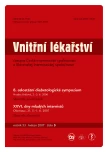-
Medical journals
- Career
Outline of the physiology and pathophysiology of the senses
Authors: O. Kittnar
Authors‘ workplace: Fyziologický ústav 1. lékařské fakulty UK, Praha, přednosta prof. MUDr. Otomar Kittnar, CSc.
Published in: Vnitř Lék 2007; 53(5): 477-482
Category:
Overview
Sense organs are considered as systems that detect information from the outer and inner environment and transfer it to the central nervous system where it is processed by a series of brain structures which make it the basis for the conscious interpretation of the surrounding world. The work discusses sense receptors as nerve structures recording specific forms of energy in our surroundings and their key function, so-called transduction, i.e. the conversion of energy of a given modality to electrical energy of the action potentials of afferent nerves. The information encoded in this form is then brought together in subcortical (thalamic) centres for processing and synthesis in the cerebral cortex. The specific implementation of this general framework is given for each of the main sense systems: somatosensory, sight, hearing, vestibular, taste and smell. The basic disorders of sense perception, their usual aetiologies and the pathogenic mechanisms responsible for their development and symptoms are outlined briefly.
Key words:
senses – receptor – transduction – afferent pathway – thalamus – cerebral cortex
Sources
1. Trojan S et al. Lékařská fyziologie. 4. ed. Praha: Avicenum-Grada Praha 2003.
2. Nečas E et al. Patologická fyziologie orgánových systémů. Praha: Karolinum 2003: Vol 2.
3. Borley NR, Achan V. Instant Physiology. Oxford: Blackwell Publishing 2005.
Labels
Diabetology Endocrinology Internal medicine
Article was published inInternal Medicine

2007 Issue 5-
All articles in this issue
- Outline of the physiology and pathophysiology of the senses
- Olfaction and gustation in diabetes
- Diabetes mellitus and cognitive impairments
- Examination of tactile disorders in diabetic patients and cooperation with a neurologist
- Diabetic ophthalmopathy
- Pathogenesis of diabetic retinopathy
- Cataracts, glaucoma and diabetes mellitus
- Surgical treatment of diabetic retinopathy
- Pharmacological treatment of diabetic retinopathy
- Inflammatory diseases of the eye
- Thyroid orbitopathy and diabetes
- Sensorineural hearing loss in diabetes. Prosthetic care in hearing impaired patients
- Tinnitus and diabetes
- Development of opinions on physical exercise for diabetics
- Exercise therapy for patients with metabolic syndrome
- Metabolic importance of muscles and the role of sports in diabetic patients
- Nutrition for diabetics in relation to physical exertion
- Therapeutic regimes accompanying physical exercise for diabetics
- Increased activity of the sympathetic nervous system and the possibilities for therapeutic influence
- Defining the level of physical activity for a diabetic who is obese
- Physical activity centre VŠTJ MEDICINA Prague – rehabilitation for diabetics
- Rehabilitation and prosthetic care for diabetic patients after the extremity amputation
- Editorial
- Internal Medicine
- Journal archive
- Current issue
- Online only
- About the journal
Most read in this issue- Inflammatory diseases of the eye
- Tinnitus and diabetes
- Increased activity of the sympathetic nervous system and the possibilities for therapeutic influence
- Olfaction and gustation in diabetes
Login#ADS_BOTTOM_SCRIPTS#Forgotten passwordEnter the email address that you registered with. We will send you instructions on how to set a new password.
- Career

